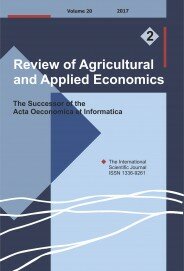KEYWORDS:
Income Diversification, Generalized Linear Model, Simpson Index of Diversification, Ghana
DOI NUMBER:
10.15414/raae.2018.21.01.55-63
ABSTRACT:
This study explores the determinants of income diversification using a sample of 200 farm-level data collected from households in the Garu-Tampane district, Ghana. The Simpson Index of Diversification was used to determine the extent of income diversification while Fractional Response Model, particularly Generalized Linear Model (GLM) was employed to identify the determinants of income diversification. Results from the Simpson Index of Diversification showed that the average income diversification index was 0.65 with the minimum and maximum of 0.13 and 0.83, respectively. No farm household was found to depend solely on a single source of income for its survival. The results from the Generalized Linear Model revealed that extension services, attendance to demonstration fields, membership of Farmer-based Organizations (FBOs), farmer accessibility to credit, the number of days spent on on-farm activities per month and the number of years in maize farming significantly influence income diversification. The study, therefore, concludes that farm-level policies geared towards alternative sources of income for the rural farm household should focus on improving extension services, the formation of farmer-based organizations, use of demonstration fields as well as ensuring farmers’ accessibility to credit.
Please Cite this Article published as:
Gilbert DAGUNGA, Dennis SEDEM EHIAKPOR, Isaac KWABENA PARRY, Gideon DANSO-ABBEAM (2018) Determinants Of Income Diversification Among Maize Farm Households In The Garu-tempane District, Ghana. Review of Agricultural and Applied Economics. Advance online publication. doi: 10.15414/raae.2018.21.01.55-63
FULL TEXT PDF:
▼ direct download link| view online in fullscreen ▲

